Corporate Finance and Financial Statement Analysis: Whirlpool
VerifiedAdded on 2023/06/18
|8
|1458
|452
Report
AI Summary
This report provides a comprehensive credit risk assessment of Whirlpool Corporation using financial statement analysis for the years 2017, 2018, and 2019. It delves into key financial ratios such as profitability, liquidity, and solvency to determine the company's creditworthiness. The analysis reveals that while Whirlpool has shown improvement in profitability and solvency, its liquidity position requires attention. The report concludes that the company faces a moderate level of credit risk, which can be mitigated through better credit policies and risk management strategies. The ratio analysis serves as a valuable tool in understanding the financial health and performance of Whirlpool, aiding in informed decision-making regarding debt payments and overall financial stability. Desklib provides access to similar solved assignments and resources for students.
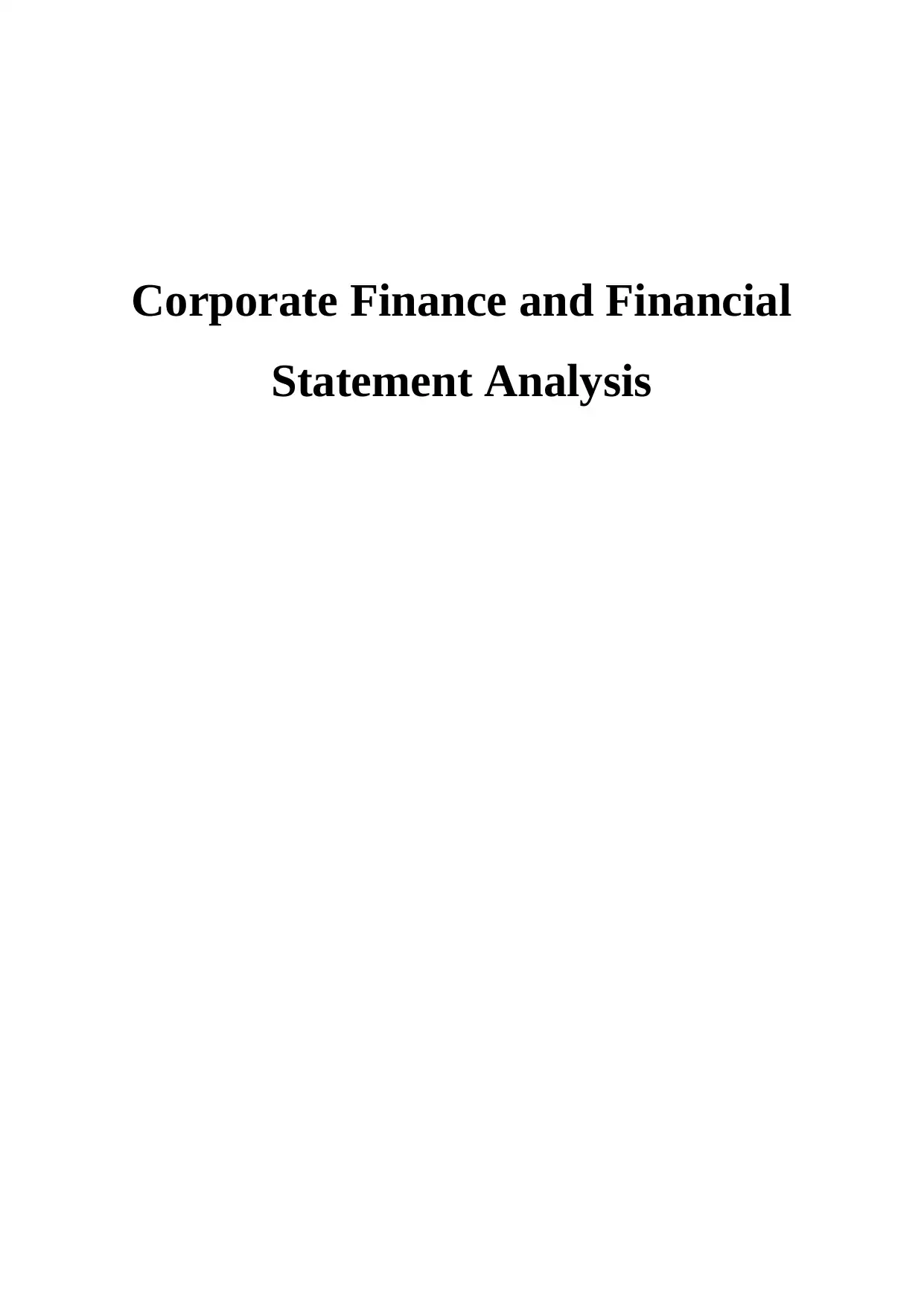
Corporate Finance and Financial
Statement Analysis
Statement Analysis
Paraphrase This Document
Need a fresh take? Get an instant paraphrase of this document with our AI Paraphraser
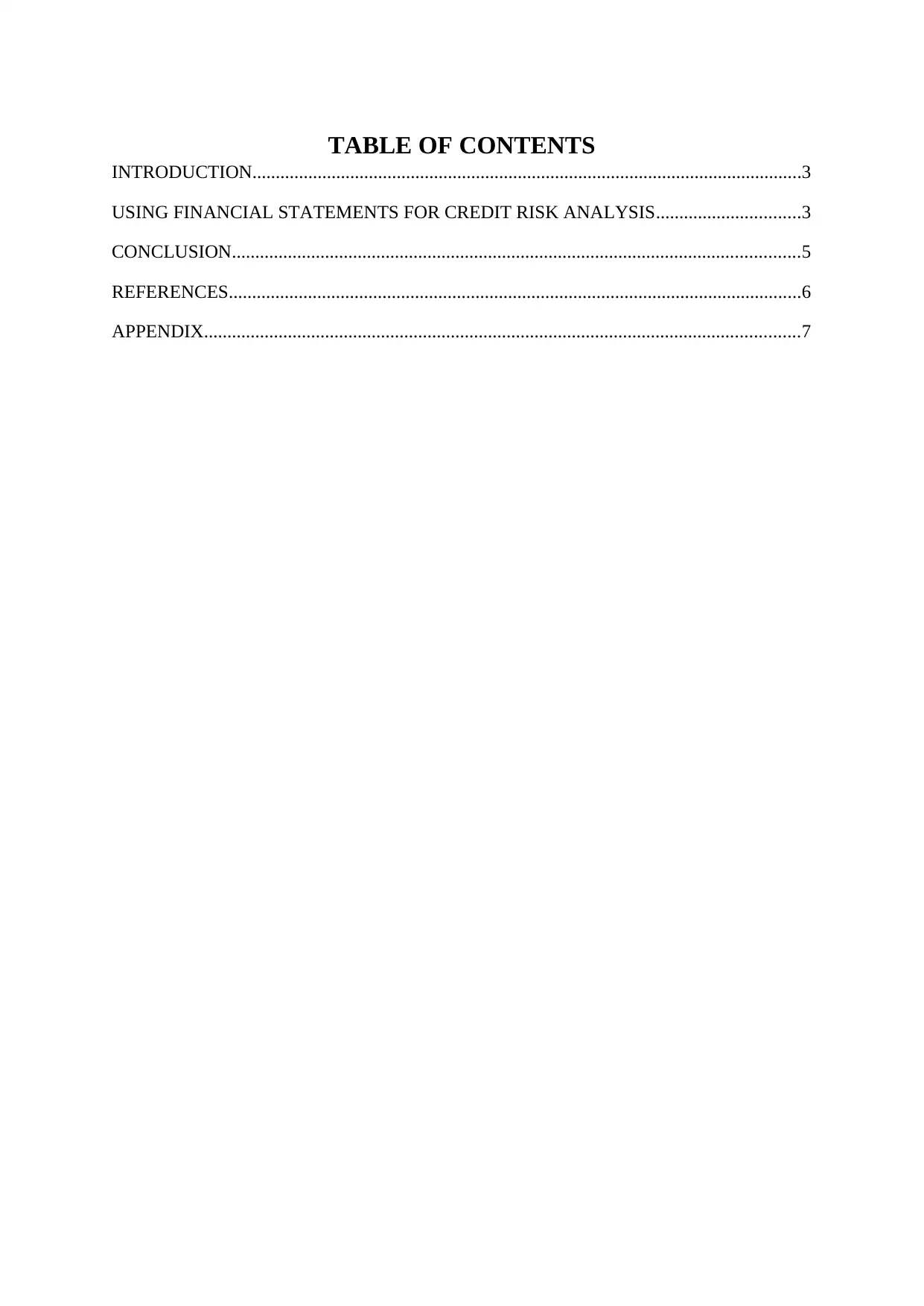
TABLE OF CONTENTS
INTRODUCTION......................................................................................................................3
USING FINANCIAL STATEMENTS FOR CREDIT RISK ANALYSIS...............................3
CONCLUSION..........................................................................................................................5
REFERENCES...........................................................................................................................6
APPENDIX................................................................................................................................7
INTRODUCTION......................................................................................................................3
USING FINANCIAL STATEMENTS FOR CREDIT RISK ANALYSIS...............................3
CONCLUSION..........................................................................................................................5
REFERENCES...........................................................................................................................6
APPENDIX................................................................................................................................7
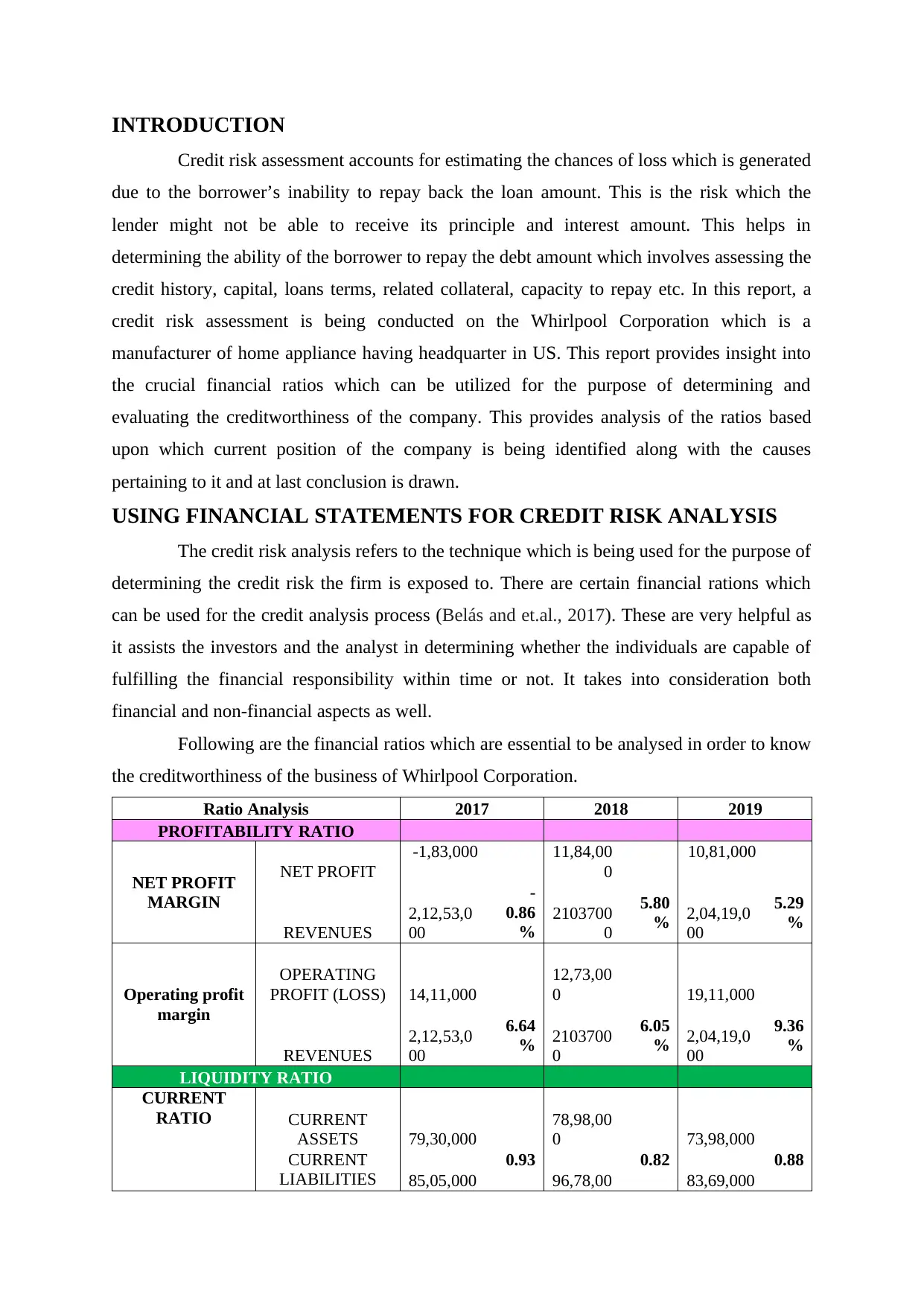
INTRODUCTION
Credit risk assessment accounts for estimating the chances of loss which is generated
due to the borrower’s inability to repay back the loan amount. This is the risk which the
lender might not be able to receive its principle and interest amount. This helps in
determining the ability of the borrower to repay the debt amount which involves assessing the
credit history, capital, loans terms, related collateral, capacity to repay etc. In this report, a
credit risk assessment is being conducted on the Whirlpool Corporation which is a
manufacturer of home appliance having headquarter in US. This report provides insight into
the crucial financial ratios which can be utilized for the purpose of determining and
evaluating the creditworthiness of the company. This provides analysis of the ratios based
upon which current position of the company is being identified along with the causes
pertaining to it and at last conclusion is drawn.
USING FINANCIAL STATEMENTS FOR CREDIT RISK ANALYSIS
The credit risk analysis refers to the technique which is being used for the purpose of
determining the credit risk the firm is exposed to. There are certain financial rations which
can be used for the credit analysis process (Belás and et.al., 2017). These are very helpful as
it assists the investors and the analyst in determining whether the individuals are capable of
fulfilling the financial responsibility within time or not. It takes into consideration both
financial and non-financial aspects as well.
Following are the financial ratios which are essential to be analysed in order to know
the creditworthiness of the business of Whirlpool Corporation.
Ratio Analysis 2017 2018 2019
PROFITABILITY RATIO
NET PROFIT
MARGIN
NET PROFIT
-1,83,000 11,84,00
0
10,81,000
REVENUES
2,12,53,0
00
-
0.86
%
2103700
0
5.80
% 2,04,19,0
00
5.29
%
Operating profit
margin
OPERATING
PROFIT (LOSS) 14,11,000
12,73,00
0 19,11,000
REVENUES
2,12,53,0
00
6.64
% 2103700
0
6.05
% 2,04,19,0
00
9.36
%
LIQUIDITY RATIO
CURRENT
RATIO CURRENT
ASSETS 79,30,000
78,98,00
0 73,98,000
CURRENT
LIABILITIES 85,05,000
0.93
96,78,00
0.82
83,69,000
0.88
Credit risk assessment accounts for estimating the chances of loss which is generated
due to the borrower’s inability to repay back the loan amount. This is the risk which the
lender might not be able to receive its principle and interest amount. This helps in
determining the ability of the borrower to repay the debt amount which involves assessing the
credit history, capital, loans terms, related collateral, capacity to repay etc. In this report, a
credit risk assessment is being conducted on the Whirlpool Corporation which is a
manufacturer of home appliance having headquarter in US. This report provides insight into
the crucial financial ratios which can be utilized for the purpose of determining and
evaluating the creditworthiness of the company. This provides analysis of the ratios based
upon which current position of the company is being identified along with the causes
pertaining to it and at last conclusion is drawn.
USING FINANCIAL STATEMENTS FOR CREDIT RISK ANALYSIS
The credit risk analysis refers to the technique which is being used for the purpose of
determining the credit risk the firm is exposed to. There are certain financial rations which
can be used for the credit analysis process (Belás and et.al., 2017). These are very helpful as
it assists the investors and the analyst in determining whether the individuals are capable of
fulfilling the financial responsibility within time or not. It takes into consideration both
financial and non-financial aspects as well.
Following are the financial ratios which are essential to be analysed in order to know
the creditworthiness of the business of Whirlpool Corporation.
Ratio Analysis 2017 2018 2019
PROFITABILITY RATIO
NET PROFIT
MARGIN
NET PROFIT
-1,83,000 11,84,00
0
10,81,000
REVENUES
2,12,53,0
00
-
0.86
%
2103700
0
5.80
% 2,04,19,0
00
5.29
%
Operating profit
margin
OPERATING
PROFIT (LOSS) 14,11,000
12,73,00
0 19,11,000
REVENUES
2,12,53,0
00
6.64
% 2103700
0
6.05
% 2,04,19,0
00
9.36
%
LIQUIDITY RATIO
CURRENT
RATIO CURRENT
ASSETS 79,30,000
78,98,00
0 73,98,000
CURRENT
LIABILITIES 85,05,000
0.93
96,78,00
0.82
83,69,000
0.88
⊘ This is a preview!⊘
Do you want full access?
Subscribe today to unlock all pages.

Trusted by 1+ million students worldwide
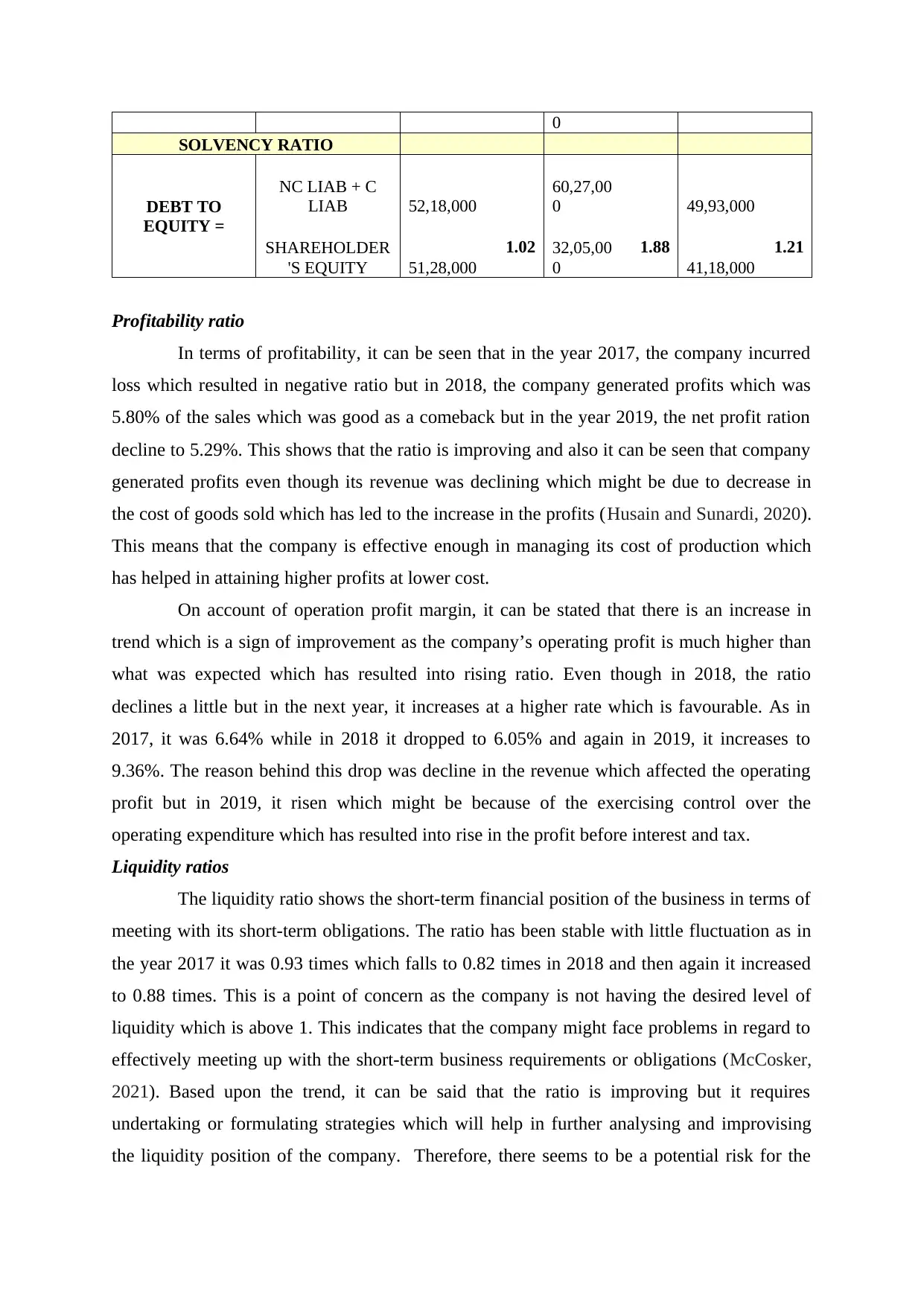
0
SOLVENCY RATIO
DEBT TO
EQUITY =
NC LIAB + C
LIAB 52,18,000
60,27,00
0 49,93,000
SHAREHOLDER
'S EQUITY 51,28,000
1.02 32,05,00
0
1.88
41,18,000
1.21
Profitability ratio
In terms of profitability, it can be seen that in the year 2017, the company incurred
loss which resulted in negative ratio but in 2018, the company generated profits which was
5.80% of the sales which was good as a comeback but in the year 2019, the net profit ration
decline to 5.29%. This shows that the ratio is improving and also it can be seen that company
generated profits even though its revenue was declining which might be due to decrease in
the cost of goods sold which has led to the increase in the profits (Husain and Sunardi, 2020).
This means that the company is effective enough in managing its cost of production which
has helped in attaining higher profits at lower cost.
On account of operation profit margin, it can be stated that there is an increase in
trend which is a sign of improvement as the company’s operating profit is much higher than
what was expected which has resulted into rising ratio. Even though in 2018, the ratio
declines a little but in the next year, it increases at a higher rate which is favourable. As in
2017, it was 6.64% while in 2018 it dropped to 6.05% and again in 2019, it increases to
9.36%. The reason behind this drop was decline in the revenue which affected the operating
profit but in 2019, it risen which might be because of the exercising control over the
operating expenditure which has resulted into rise in the profit before interest and tax.
Liquidity ratios
The liquidity ratio shows the short-term financial position of the business in terms of
meeting with its short-term obligations. The ratio has been stable with little fluctuation as in
the year 2017 it was 0.93 times which falls to 0.82 times in 2018 and then again it increased
to 0.88 times. This is a point of concern as the company is not having the desired level of
liquidity which is above 1. This indicates that the company might face problems in regard to
effectively meeting up with the short-term business requirements or obligations (McCosker,
2021). Based upon the trend, it can be said that the ratio is improving but it requires
undertaking or formulating strategies which will help in further analysing and improvising
the liquidity position of the company. Therefore, there seems to be a potential risk for the
SOLVENCY RATIO
DEBT TO
EQUITY =
NC LIAB + C
LIAB 52,18,000
60,27,00
0 49,93,000
SHAREHOLDER
'S EQUITY 51,28,000
1.02 32,05,00
0
1.88
41,18,000
1.21
Profitability ratio
In terms of profitability, it can be seen that in the year 2017, the company incurred
loss which resulted in negative ratio but in 2018, the company generated profits which was
5.80% of the sales which was good as a comeback but in the year 2019, the net profit ration
decline to 5.29%. This shows that the ratio is improving and also it can be seen that company
generated profits even though its revenue was declining which might be due to decrease in
the cost of goods sold which has led to the increase in the profits (Husain and Sunardi, 2020).
This means that the company is effective enough in managing its cost of production which
has helped in attaining higher profits at lower cost.
On account of operation profit margin, it can be stated that there is an increase in
trend which is a sign of improvement as the company’s operating profit is much higher than
what was expected which has resulted into rising ratio. Even though in 2018, the ratio
declines a little but in the next year, it increases at a higher rate which is favourable. As in
2017, it was 6.64% while in 2018 it dropped to 6.05% and again in 2019, it increases to
9.36%. The reason behind this drop was decline in the revenue which affected the operating
profit but in 2019, it risen which might be because of the exercising control over the
operating expenditure which has resulted into rise in the profit before interest and tax.
Liquidity ratios
The liquidity ratio shows the short-term financial position of the business in terms of
meeting with its short-term obligations. The ratio has been stable with little fluctuation as in
the year 2017 it was 0.93 times which falls to 0.82 times in 2018 and then again it increased
to 0.88 times. This is a point of concern as the company is not having the desired level of
liquidity which is above 1. This indicates that the company might face problems in regard to
effectively meeting up with the short-term business requirements or obligations (McCosker,
2021). Based upon the trend, it can be said that the ratio is improving but it requires
undertaking or formulating strategies which will help in further analysing and improvising
the liquidity position of the company. Therefore, there seems to be a potential risk for the
Paraphrase This Document
Need a fresh take? Get an instant paraphrase of this document with our AI Paraphraser
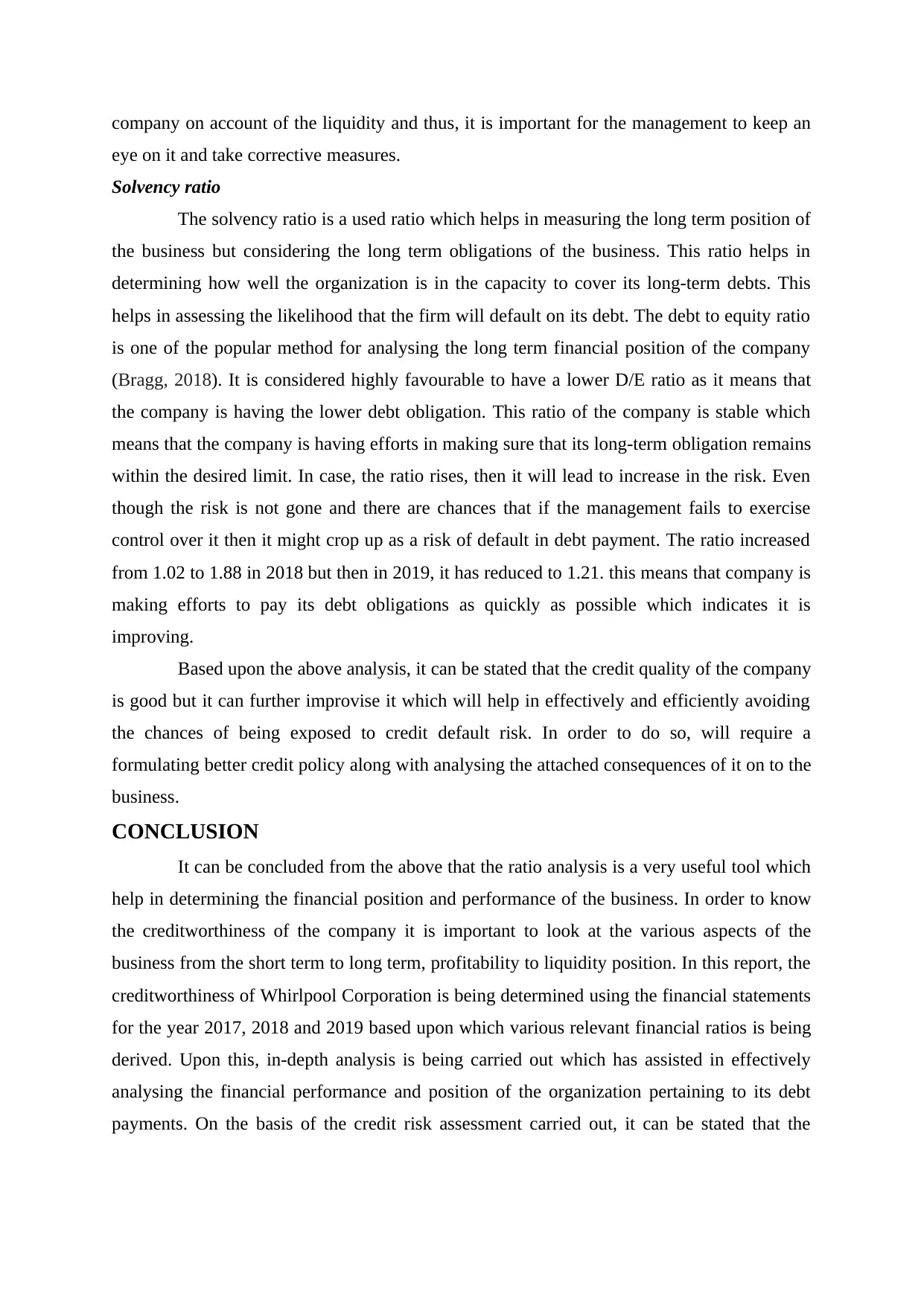
company on account of the liquidity and thus, it is important for the management to keep an
eye on it and take corrective measures.
Solvency ratio
The solvency ratio is a used ratio which helps in measuring the long term position of
the business but considering the long term obligations of the business. This ratio helps in
determining how well the organization is in the capacity to cover its long-term debts. This
helps in assessing the likelihood that the firm will default on its debt. The debt to equity ratio
is one of the popular method for analysing the long term financial position of the company
(Bragg, 2018). It is considered highly favourable to have a lower D/E ratio as it means that
the company is having the lower debt obligation. This ratio of the company is stable which
means that the company is having efforts in making sure that its long-term obligation remains
within the desired limit. In case, the ratio rises, then it will lead to increase in the risk. Even
though the risk is not gone and there are chances that if the management fails to exercise
control over it then it might crop up as a risk of default in debt payment. The ratio increased
from 1.02 to 1.88 in 2018 but then in 2019, it has reduced to 1.21. this means that company is
making efforts to pay its debt obligations as quickly as possible which indicates it is
improving.
Based upon the above analysis, it can be stated that the credit quality of the company
is good but it can further improvise it which will help in effectively and efficiently avoiding
the chances of being exposed to credit default risk. In order to do so, will require a
formulating better credit policy along with analysing the attached consequences of it on to the
business.
CONCLUSION
It can be concluded from the above that the ratio analysis is a very useful tool which
help in determining the financial position and performance of the business. In order to know
the creditworthiness of the company it is important to look at the various aspects of the
business from the short term to long term, profitability to liquidity position. In this report, the
creditworthiness of Whirlpool Corporation is being determined using the financial statements
for the year 2017, 2018 and 2019 based upon which various relevant financial ratios is being
derived. Upon this, in-depth analysis is being carried out which has assisted in effectively
analysing the financial performance and position of the organization pertaining to its debt
payments. On the basis of the credit risk assessment carried out, it can be stated that the
eye on it and take corrective measures.
Solvency ratio
The solvency ratio is a used ratio which helps in measuring the long term position of
the business but considering the long term obligations of the business. This ratio helps in
determining how well the organization is in the capacity to cover its long-term debts. This
helps in assessing the likelihood that the firm will default on its debt. The debt to equity ratio
is one of the popular method for analysing the long term financial position of the company
(Bragg, 2018). It is considered highly favourable to have a lower D/E ratio as it means that
the company is having the lower debt obligation. This ratio of the company is stable which
means that the company is having efforts in making sure that its long-term obligation remains
within the desired limit. In case, the ratio rises, then it will lead to increase in the risk. Even
though the risk is not gone and there are chances that if the management fails to exercise
control over it then it might crop up as a risk of default in debt payment. The ratio increased
from 1.02 to 1.88 in 2018 but then in 2019, it has reduced to 1.21. this means that company is
making efforts to pay its debt obligations as quickly as possible which indicates it is
improving.
Based upon the above analysis, it can be stated that the credit quality of the company
is good but it can further improvise it which will help in effectively and efficiently avoiding
the chances of being exposed to credit default risk. In order to do so, will require a
formulating better credit policy along with analysing the attached consequences of it on to the
business.
CONCLUSION
It can be concluded from the above that the ratio analysis is a very useful tool which
help in determining the financial position and performance of the business. In order to know
the creditworthiness of the company it is important to look at the various aspects of the
business from the short term to long term, profitability to liquidity position. In this report, the
creditworthiness of Whirlpool Corporation is being determined using the financial statements
for the year 2017, 2018 and 2019 based upon which various relevant financial ratios is being
derived. Upon this, in-depth analysis is being carried out which has assisted in effectively
analysing the financial performance and position of the organization pertaining to its debt
payments. On the basis of the credit risk assessment carried out, it can be stated that the
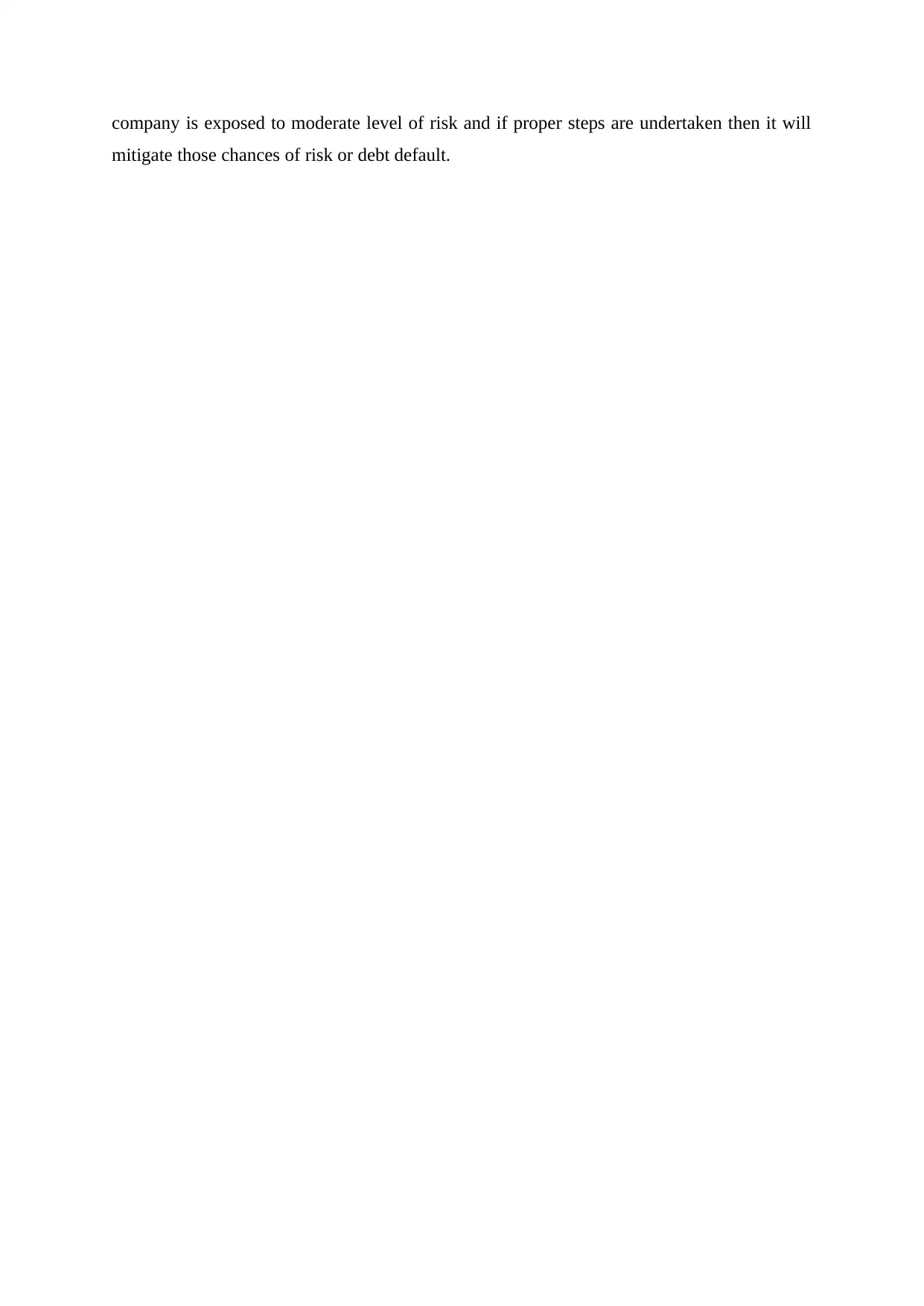
company is exposed to moderate level of risk and if proper steps are undertaken then it will
mitigate those chances of risk or debt default.
mitigate those chances of risk or debt default.
⊘ This is a preview!⊘
Do you want full access?
Subscribe today to unlock all pages.

Trusted by 1+ million students worldwide
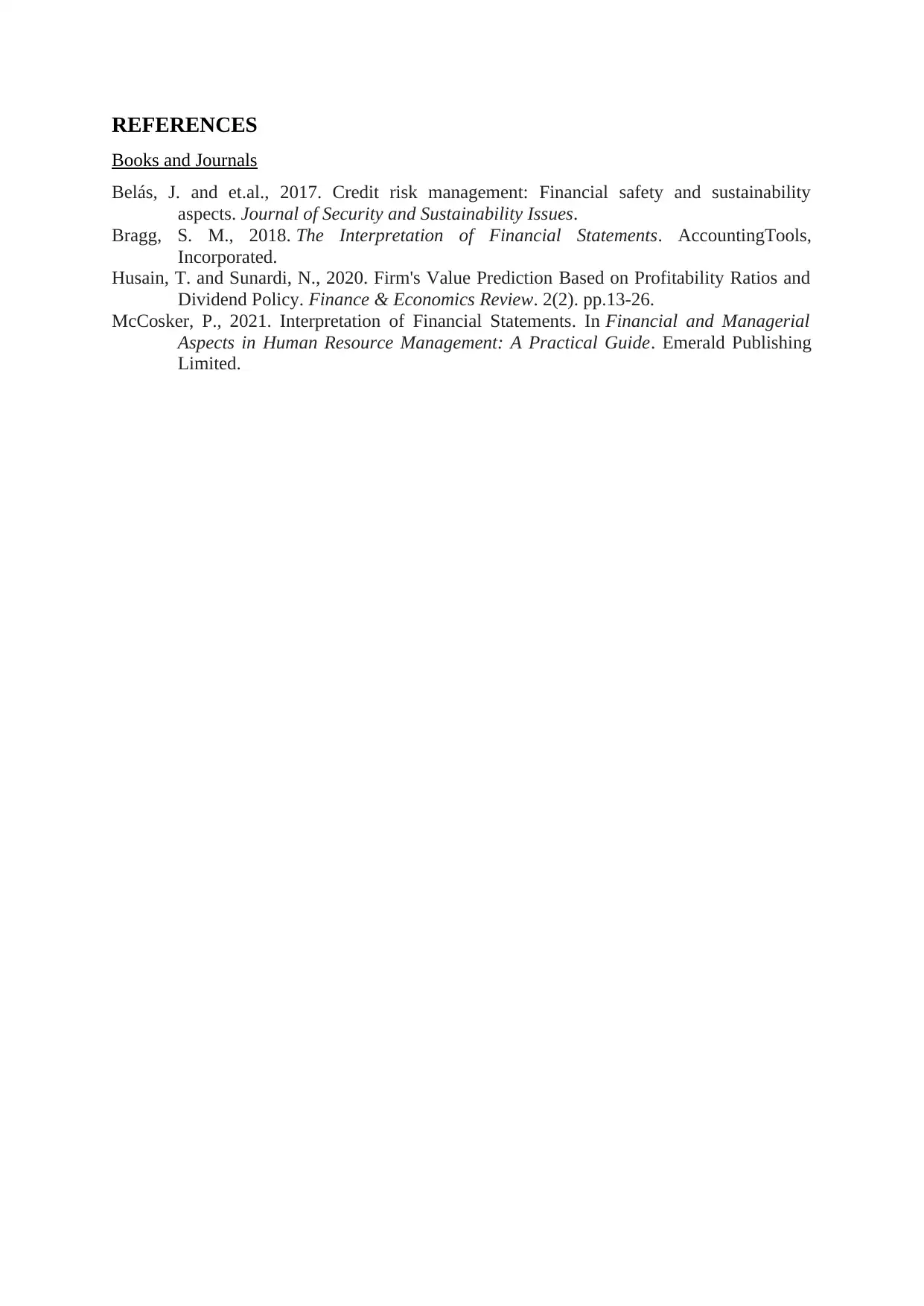
REFERENCES
Books and Journals
Belás, J. and et.al., 2017. Credit risk management: Financial safety and sustainability
aspects. Journal of Security and Sustainability Issues.
Bragg, S. M., 2018. The Interpretation of Financial Statements. AccountingTools,
Incorporated.
Husain, T. and Sunardi, N., 2020. Firm's Value Prediction Based on Profitability Ratios and
Dividend Policy. Finance & Economics Review. 2(2). pp.13-26.
McCosker, P., 2021. Interpretation of Financial Statements. In Financial and Managerial
Aspects in Human Resource Management: A Practical Guide. Emerald Publishing
Limited.
Books and Journals
Belás, J. and et.al., 2017. Credit risk management: Financial safety and sustainability
aspects. Journal of Security and Sustainability Issues.
Bragg, S. M., 2018. The Interpretation of Financial Statements. AccountingTools,
Incorporated.
Husain, T. and Sunardi, N., 2020. Firm's Value Prediction Based on Profitability Ratios and
Dividend Policy. Finance & Economics Review. 2(2). pp.13-26.
McCosker, P., 2021. Interpretation of Financial Statements. In Financial and Managerial
Aspects in Human Resource Management: A Practical Guide. Emerald Publishing
Limited.
Paraphrase This Document
Need a fresh take? Get an instant paraphrase of this document with our AI Paraphraser
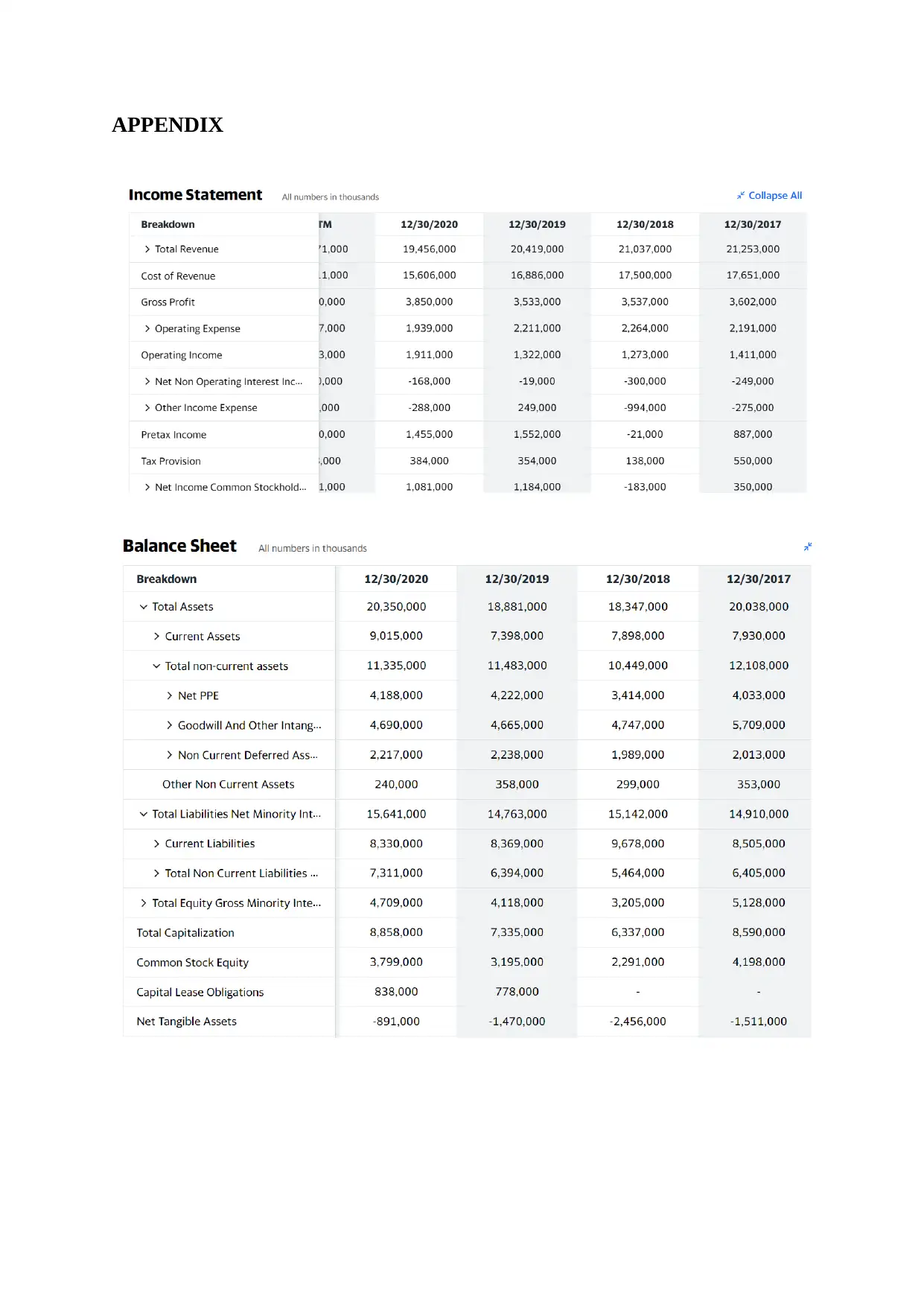
APPENDIX
1 out of 8
Related Documents
Your All-in-One AI-Powered Toolkit for Academic Success.
+13062052269
info@desklib.com
Available 24*7 on WhatsApp / Email
![[object Object]](/_next/static/media/star-bottom.7253800d.svg)
Unlock your academic potential
Copyright © 2020–2025 A2Z Services. All Rights Reserved. Developed and managed by ZUCOL.





